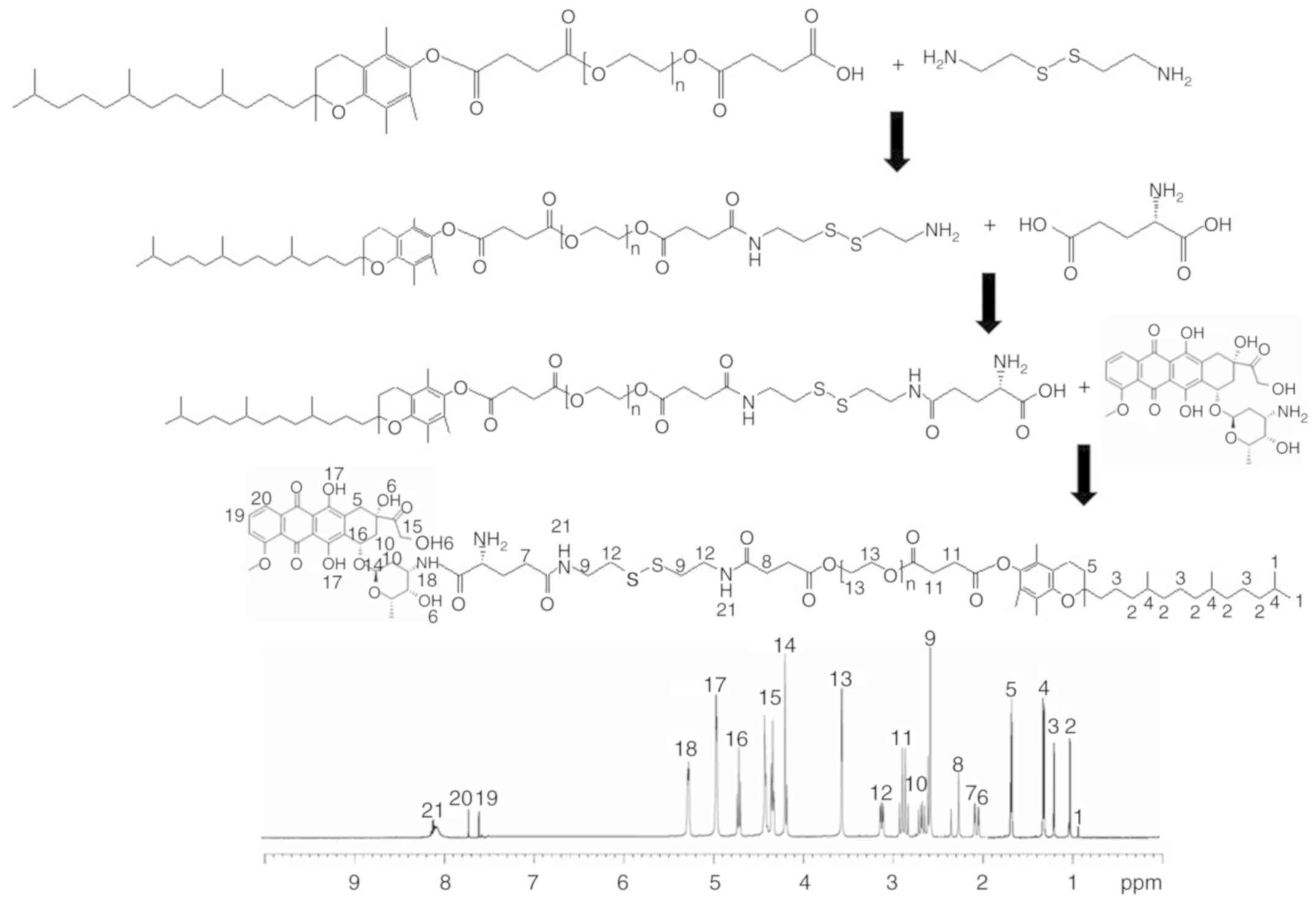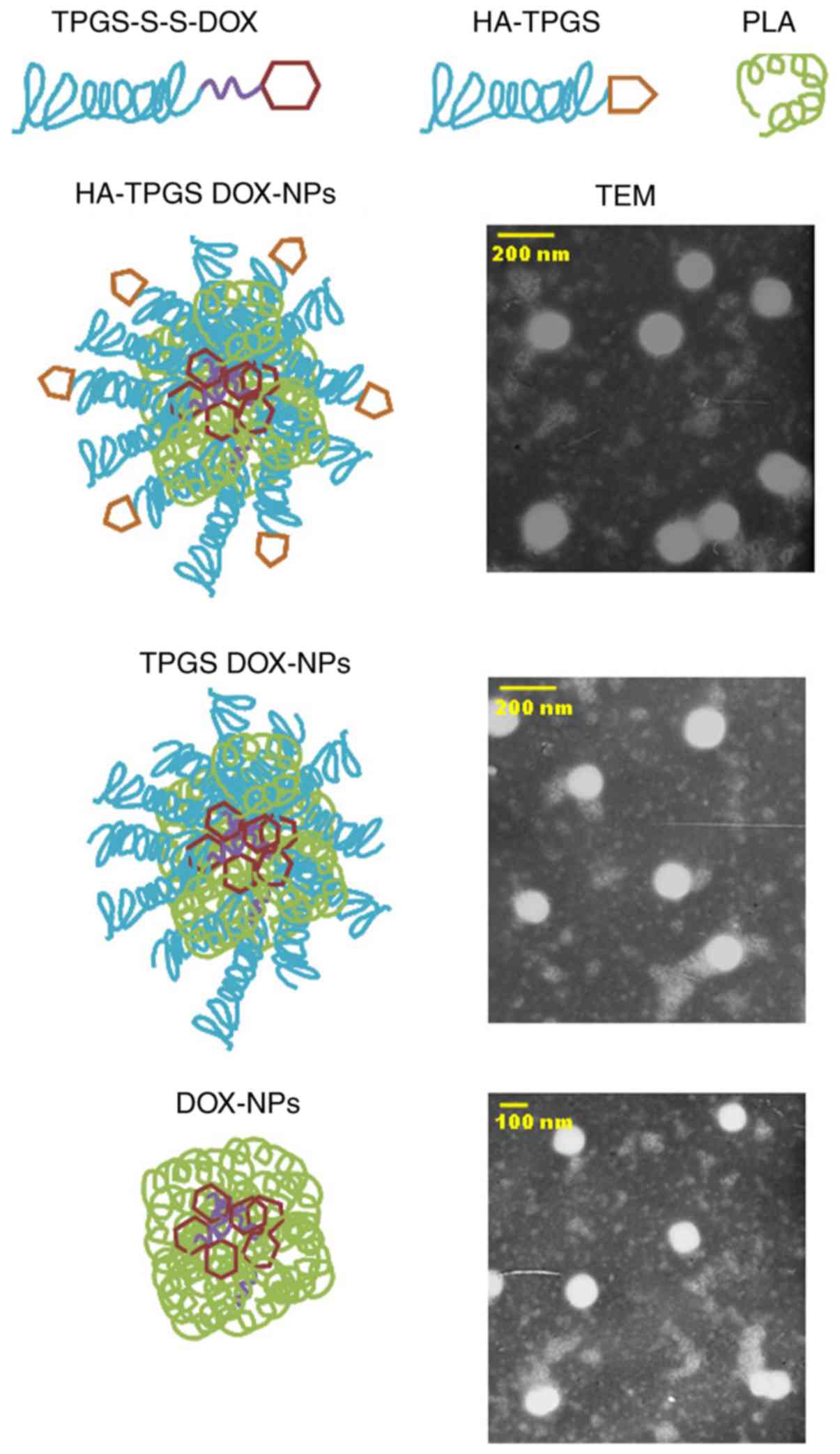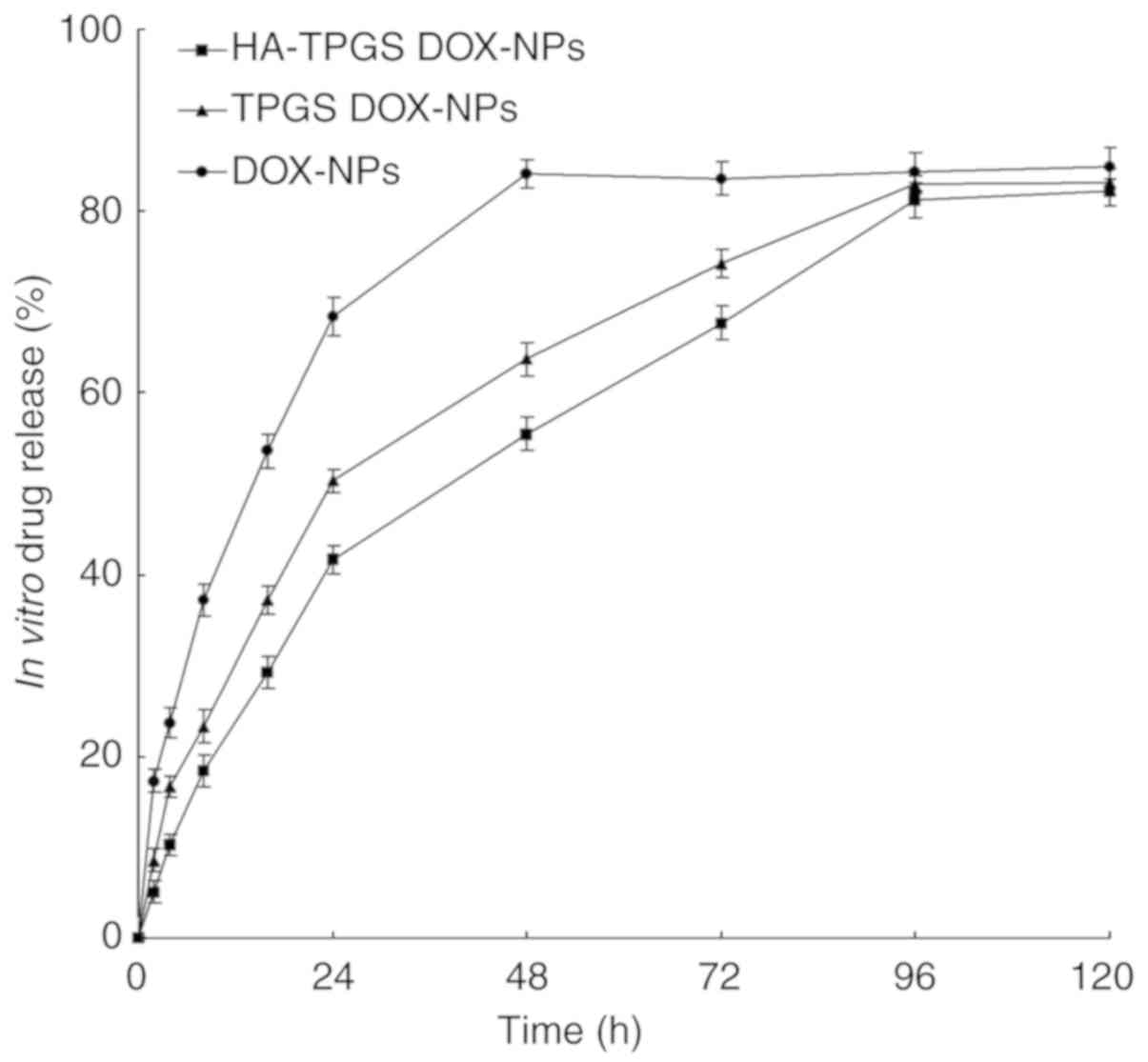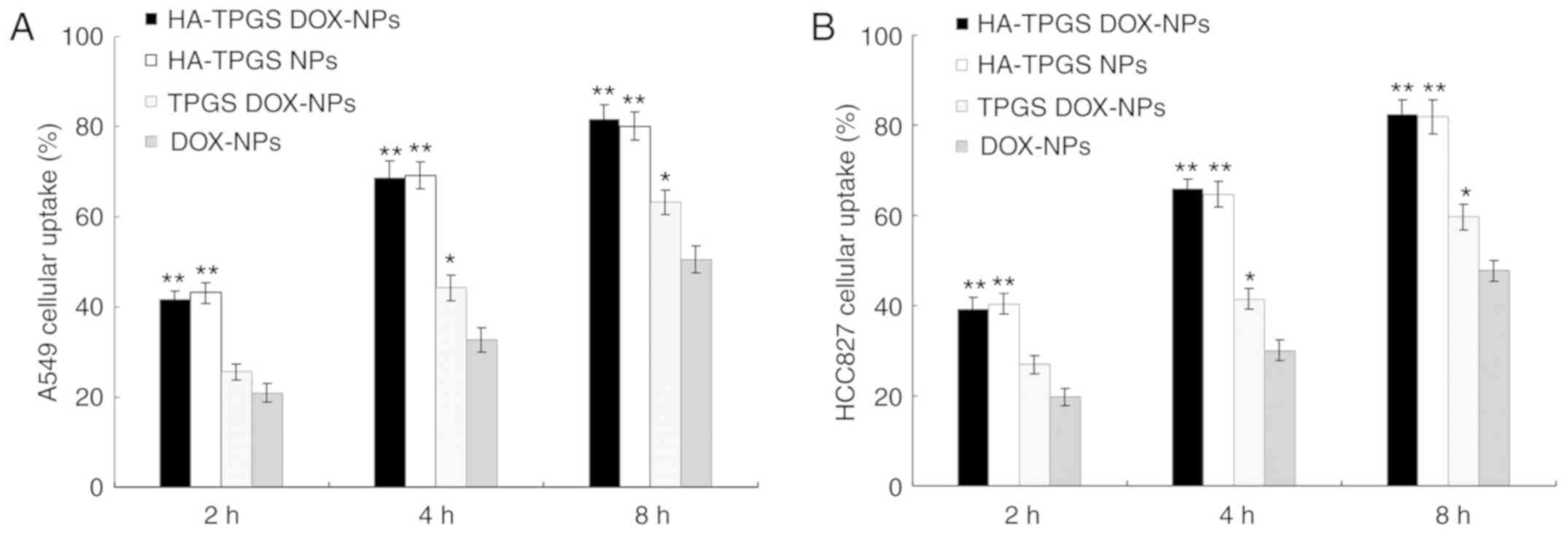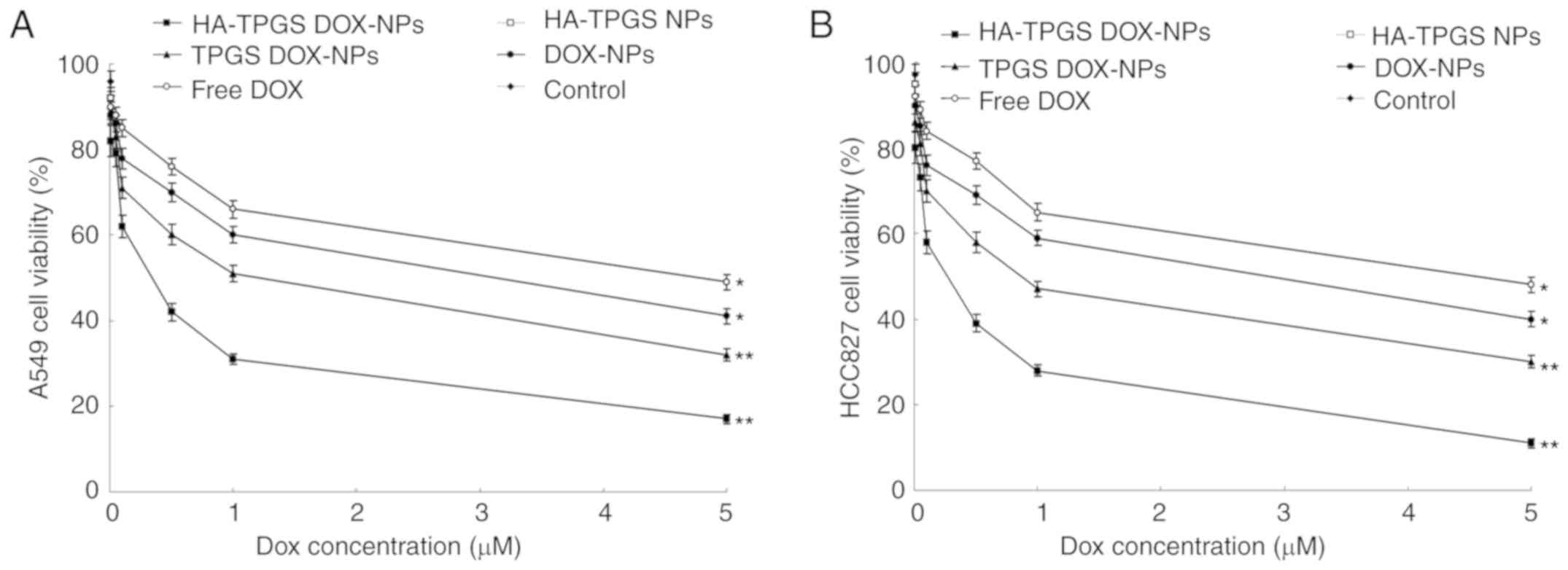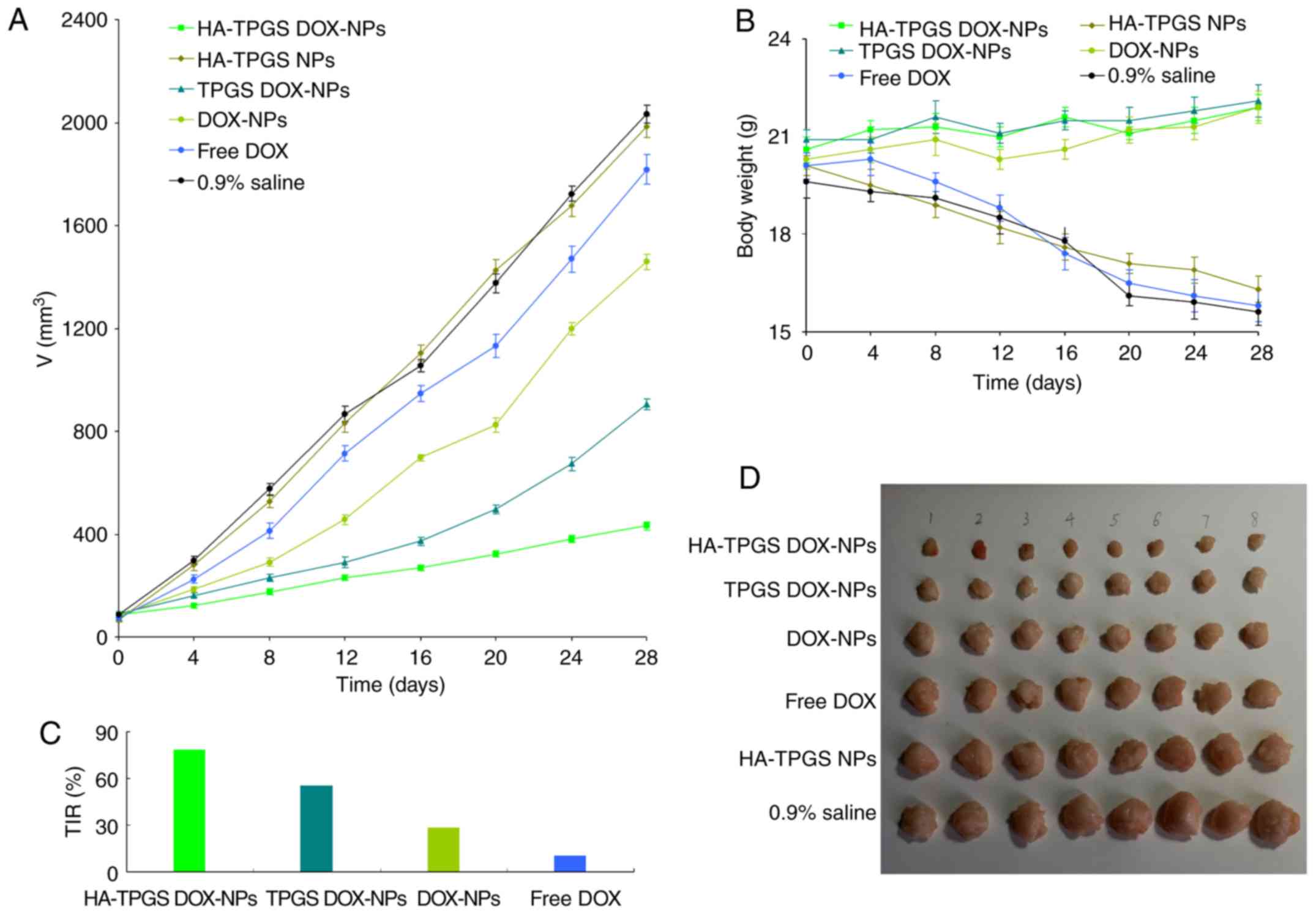|
1
|
Siegel RL, Miller KD and Jemal A: Cancer
statistics, 2017. CA Cancer J Clin. 67:7–30. 2017. View Article : Google Scholar : PubMed/NCBI
|
|
2
|
Aftab S, Shah A, Nadhman A, Kurbanoglu S,
Aysıl Ozkan S, Dionysiou DD, Shukla SS and Aminabhavi TM:
Nanomedicine: An effective tool in cancer therapy. Int J Pharm.
540:132–149. 2018. View Article : Google Scholar : PubMed/NCBI
|
|
3
|
Liu B, Han L, Liu J, Han S, Chen Z and
Jiang L: Co-delivery of paclitaxel and TOS-cisplatin via
TAT-targeted solid lipid nanoparticles with synergistic antitumor
activity against cervical cancer. Int J Nanomedicine. 12:955–968.
2017. View Article : Google Scholar : PubMed/NCBI
|
|
4
|
Mura S, Bui DT, Couvreur P and Nicolas J:
Lipid prodrug nanocarriers in cancer therapy. J Control Release.
208:25–41. 2015. View Article : Google Scholar : PubMed/NCBI
|
|
5
|
Mi Y, Zhao J and Feng SS: Vitamin E TPGS
prodrug micelles for hydrophilic drug delivery with neuroprotective
effects. Int J Pharm. 438:98–106. 2012. View Article : Google Scholar : PubMed/NCBI
|
|
6
|
Anbharasi V, Cao N and Feng SS:
Doxorubicin conjugated to D-alpha-tocopheryl polyethylene glycol
succinate and folic acid as a prodrug for targeted chemotherapy. J
Biomed Mater Res A. 94:730–743. 2010.PubMed/NCBI
|
|
7
|
Xu Z, Liu S, Kang Y and Wang M:
Glutathione- and pH-responsive nonporous silica prodrug
nanoparticles for controlled release and cancer therapy. Nanoscale.
7:5859–5868. 2015. View Article : Google Scholar : PubMed/NCBI
|
|
8
|
Tjin CC, Otley KD, Baguley TD, Kurup P, Xu
J, Nairn AC, Lombroso PJ and Ellman JA: Glutathione-responsive
Selenosulfide prodrugs as a platform strategy for potent and
selective mechanism-based inhibition of protein tyrosine
phosphatases. ACS Cent Sci. 3:1322–1328. 2017. View Article : Google Scholar : PubMed/NCBI
|
|
9
|
Wang Y, Liu D, Zheng Q, Zhao Q, Zhang H,
Ma Y, Fallon JK, Fu Q, Haynes MT, Lin G, et al: Disulfide bond
bridge insertion turns hydrophobic anticancer prodrugs into
self-assembled nanomedicines. Nano Lett. 14:5577–5583. 2014.
View Article : Google Scholar : PubMed/NCBI
|
|
10
|
Anjukandi P, Dopieralski P, Ribas-Arino J
and Marx D: The effect of tensile stress on the conformational free
energy landscape of disulfide bonds. PLoS One. 9:e1088122014.
View Article : Google Scholar : PubMed/NCBI
|
|
11
|
Wang S, Zhang J, Wang Y and Chen M:
Hyaluronic acid-coated PEI-PLGA nanoparticles mediated co-delivery
of doxorubicin and miR-542-3p for triple negative breast cancer
therapy. Nanomedicine. 12:411–420. 2016. View Article : Google Scholar : PubMed/NCBI
|
|
12
|
Xu W, Qian J, Zhang Y, Suo A, Cui N, Wang
J, Yao Y and Wang H: A double-network poly(Nε-acryloyl
L-lysine)/hyaluronic acid hydrogel as a mimic of the breast tumor
microenvironment. Acta Biomater. 33:131–141. 2016. View Article : Google Scholar : PubMed/NCBI
|
|
13
|
Duhem N, Danhier F, Pourcelle V, Schumers
JM, Bertrand O, Leduff CS, Hoeppener S, Schubert US, Gohy JF,
Marchand-Brynaert J and Préat V: Self-assembling
doxorubicin-tocopherol succinate prodrug as a new drug delivery
system: Synthesis, characterization, and in vitro and in vivo
anticancer activity. Bioconjug Chem. 25:72–81. 2014. View Article : Google Scholar : PubMed/NCBI
|
|
14
|
Zhang Z, Tan S and Feng SS: Vitamin E TPGS
as a molecular biomaterial for drug delivery. Biomaterials.
33:4889–4906. 2012. View Article : Google Scholar : PubMed/NCBI
|
|
15
|
Cao N and Feng SS: Doxorubicin conjugated
to D-alpha-tocopheryl polyethylene glycol 1000 succinate (TPGS):
Conjugation chemistry, characterization, in vitro and in vivo
evaluation. Biomaterials. 29:3856–3865. 2008. View Article : Google Scholar : PubMed/NCBI
|
|
16
|
Su Z, Chen M, Xiao Y, Sun M, Zong L,
Asghar S, Dong M, Li H, Ping Q and Zhang C: ROS-triggered and
regenerating anticancer nanosystem: An effective strategy to subdue
tumor's multidrug resistance. J Control Release. 196:370–383. 2014.
View Article : Google Scholar : PubMed/NCBI
|
|
17
|
Almeida PV, Shahbazi MA, Mäkilä E,
Kaasalainen M, Salonen J, Hirvonen J and Santos HA: Amine-modified
hyaluronic acid-functionalized porous silicon nanoparticles for
targeting breast cancer tumors. Nanoscale. 6:10377–30387. 2014.
View Article : Google Scholar : PubMed/NCBI
|
|
18
|
Parvani JG, Gujrati MD, Mack MA, Schiemann
WP and Lu ZR: Silencing β3 integrin by targeted ECO/siRNA
nanoparticles inhibits EMT and metastasis of triple-negative breast
cancer. Cancer Res. 75:2316–2325. 2015. View Article : Google Scholar : PubMed/NCBI
|
|
19
|
Shen W, Liu W, Yang H, Zhang P, Xiao C and
Chen X: A glutathione-responsive sulfur dioxide polymer prodrug as
a nanocarrier for combating drug-resistance in cancer chemotherapy.
Biomaterials. 178:706–719. 2018. View Article : Google Scholar : PubMed/NCBI
|
|
20
|
Nguyen CT, Tran TH, Amiji M, Lu X and Kasi
RM: Redox-sensitive nanoparticles from amphiphilic
cholesterol-based block copolymers for enhanced tumor intracellular
release of doxorubicin. Nanomedicine. 11:2071–2082. 2015.
View Article : Google Scholar : PubMed/NCBI
|
|
21
|
Liu K, Chen W, Yang T, Wen B, Ding D,
Keidar M, Tang J and Zhang W: Paclitaxel and quercetin
nanoparticles co-loaded in microspheres to prolong retention time
for pulmonary drug delivery. Int J Nanomedicine. 12:8239–8255,
20147. View Article : Google Scholar : PubMed/NCBI
|
|
22
|
Lee JY, Kim JS, Cho HJ and Kim DD:
Poly(styrene)-b-poly(DL-lactide) copolymer-based nanoparticles for
anticancer drug delivery. Int J Nanomedicine. 9:2803–2813.
2014.PubMed/NCBI
|
|
23
|
Jiang SP, He SN, Li YL, Feng DL, Lu XY, Du
YZ, Yu HY, Hu FQ and Yuan H: Preparation and characteristics of
lipid nanoemulsion formulations loaded with doxorubicin. Int J
Nanomedicine. 8:3141–3150. 2013.PubMed/NCBI
|
|
24
|
Jia Y, Yuan M, Yuan H, Huang X, Sui X, Cui
X, Tang F, Peng J, Chen J, Lu S, et al: Co-encapsulation of
magnetic Fe3O4 nanoparticles and doxorubicin
into biodegradable PLGA nanocarriers for intratumoral drug
delivery. Int J Nanomedicine. 7:1697–1708. 2012.PubMed/NCBI
|
|
25
|
Li S, Wang L, Li N, Liu Y and Su H:
Combination lung cancer chemotherapy: Design of a pH-sensitive
transferrin-PEG-Hz-lipid conjugate for the co-delivery of docetaxel
and baicalin. Biomed Pharmacother. 95:548–555. 2017. View Article : Google Scholar : PubMed/NCBI
|
|
26
|
Siu FY, Ye S, Lin H and Li S:
Galactosylated PLGA nanoparticles for the oral delivery of
resveratrol: Enhanced bioavailability and in vitro
anti-inflammatory activity. Int J Nanomedicine. 13:4133–4144. 2018.
View Article : Google Scholar : PubMed/NCBI
|
|
27
|
Yan J, Wang Y, Jia Y, Liu S, Tian C, Pan
W, Liu X and Wang H: Co-delivery of docetaxel and curcumin prodrug
via dual-targeted nanoparticles with synergistic antitumor activity
against prostate cancer. Biomed Pharmacother. 88:374–383. 2017.
View Article : Google Scholar : PubMed/NCBI
|
|
28
|
Ruan C, Liu L, Lu Y, Zhang Y, He X, Chen
X, Zhang Y, Chen Q, Guo Q, Sun T and Jiang C: Substance P-modified
human serum albumin nanoparticles loaded with paclitaxel for
targeted therapy of glioma. Acta Pharm Sin B. 8:85–96. 2018.
View Article : Google Scholar : PubMed/NCBI
|
|
29
|
Arab-Bafrani Z, Shahbazi-Gahrouei D,
Abbasian M and Fesharaki M: Multiple MTS assay as the alternative
method to determine survival fraction of the irradiated HT-29 colon
cancer cells. J Med Signals Sens. 6:112–116. 2016.PubMed/NCBI
|
|
30
|
Pedrosa P, Mendes R, Cabral R, Martins
LMDRS, Baptista PV and Fernandes AR: Combination of chemotherapy
and Au-nanoparticle photothermy in the visible light to tackle
doxorubicin resistance in cancer cells. Sci Rep. 8:114292018.
View Article : Google Scholar : PubMed/NCBI
|
|
31
|
Alibolandi M, Ramezani M, Abnous K,
Sadeghi F, Atyabi F, Asouri M, Ahmadi AA and Hadizadeh F: In vitro
and in vivo evaluation of therapy targeting epithelial-cell
adhesion-molecule aptamers for non-small cell lung cancer. J
Control Release. 209:88–100. 2015. View Article : Google Scholar : PubMed/NCBI
|
|
32
|
Kou CH, Han J, Han XL, Zhuang HJ and Zhao
ZM: Preparation and characterization of the Adriamycin-loaded
amphiphilic chitosan nanoparticles and their application in the
treatment of liver cancer. Oncol Lett. 14:7833–7841.
2017.PubMed/NCBI
|
|
33
|
Giang I, Boland EL and Poon GM: Prodrug
applications for targeted cancer therapy. AAPS J. 16:899–913. 2014.
View Article : Google Scholar : PubMed/NCBI
|
|
34
|
Tan S and Wang G: Redox-responsive and
pH-sensitive nanoparticles enhanced stability and anticancer
ability of erlotinib to treat lung cancer in vivo. Drug Des Devel
Ther. 11:3519–3529. 2017. View Article : Google Scholar : PubMed/NCBI
|
|
35
|
Lee BK, Yun Y and Park K: PLA micro- and
nano-particles. Adv Drug Deliv Rev. 107:176–191. 2016. View Article : Google Scholar : PubMed/NCBI
|
|
36
|
Mura S, Hillaireau H, Nicolas J, Le
Droumaguet B, Gueutin C, Zanna S, Tsapis N and Fattal E: Influence
of surface charge on the potential toxicity of PLGA nanoparticles
towards Calu-3 cells. Int J Nanomedicine. 6:2591–2605.
2011.PubMed/NCBI
|
|
37
|
Shang L, Nienhaus K and Nienhaus GU:
Engineered nanoparticles interacting with cells: Size matters. J
Nanobiotechnology. 12:52014. View Article : Google Scholar : PubMed/NCBI
|
|
38
|
Danaei M, Dehghankhold M, Ataei S,
Hasanzadeh Davarani F, Javanmard R, Dokhani A, Khorasani S and
Mozafari MR: Impact of Particle size and polydispersity index on
the clinical applications of lipidic nanocarrier systems.
Pharmaceutics. 10:E572018. View Article : Google Scholar : PubMed/NCBI
|
|
39
|
Liu J, Cheng H, Han L, Qiang Z, Zhang X,
Gao W, Zhao K and Song Y: Synergistic combination therapy of lung
cancer using paclitaxel- and triptolide-coloaded lipid-polymer
hybrid nanoparticles. Drug Des Devel Ther. 12:3199–3209. 2018.
View Article : Google Scholar : PubMed/NCBI
|
|
40
|
Cheng W, Liang C, Xu L, Liu G, Gao N, Tao
W, Luo L, Zuo Y, Wang X, Zhang X, et al: TPGS-Functionalized
polydopamine-modified mesoporous silica as drug nanocarriers for
enhanced lung cancer chemotherapy against multidrug resistance.
Small. 13:2017. View Article : Google Scholar
|
|
41
|
Rafiei P and Haddadi A: Docetaxel-loaded
PLGA and PLGA-PEG nanoparticles for intravenous application:
Pharmacokinetics and biodistribution profile. Int J Nanomedicine.
12:935–947. 2017. View Article : Google Scholar : PubMed/NCBI
|
|
42
|
Nassireslami E and Ajdarzade M: Gold
coated superparamagnetic iron oxide nanoparticles as effective
nanoparticles to eradicate breast cancer cells via photothermal
therapy. Adv Pharm Bull. 8:201–209. 2018. View Article : Google Scholar : PubMed/NCBI
|
|
43
|
Jiang L, Li X, Liu L and Zhang Q: Cellular
uptake mechanism and intracellular fate of hydrophobically modified
pullulan nanoparticles. Int J Nanomedicine. 8:1825–1834.
2013.PubMed/NCBI
|
|
44
|
Guo F, Wu J, Wu W, Huang D, Yan Q, Yang Q,
Gao Y and Yang G: PEGylated self-assembled enzyme-responsive
nanoparticles for effective targeted therapy against lung tumors. J
Nanobiotechnology. 16:572018. View Article : Google Scholar : PubMed/NCBI
|
|
45
|
Schrand AM, Lin JB and Hussain SM:
Assessment of cytotoxicity of carbon nanoparticles using
3-(4,5-dimethylthiazol-2-yl)-5-(3-carboxymethoxyphenyl)-2-(4-sulfophenyl)-2H-tetrazolium
(MTS) cell viability assay. Methods Mol Biol. 906:395–402.
2012.PubMed/NCBI
|
|
46
|
Garg A, Rai G, Lodhi S, Jain AP and Yadav
AK: Hyaluronic acid embedded cellulose acetate phthlate core/shell
nanoparticulate carrier of 5-fluorouracil. Int J Biol Macromol.
87:449–459. 2016. View Article : Google Scholar : PubMed/NCBI
|
|
47
|
Mei L, Fu L, Shi K, Zhang Q, Liu Y, Tang
J, Gao H, Zhang Z and He Q: Increased tumor targeted delivery using
a multistage liposome system functionalized with RGD, TAT and
cleavable PEG. Int J Pharm. 468:26–38. 2014. View Article : Google Scholar : PubMed/NCBI
|
|
48
|
Dong Z, Guo J, Xing X, Zhang X, Du Y and
Lu Q: RGD modified and PEGylated lipid nanoparticles loaded with
puerarin: Formulation, characterization and protective effects on
acute myocardial ischemia model. Biomed Pharmacother. 89:297–304.
2017. View Article : Google Scholar : PubMed/NCBI
|
|
49
|
Naeem M, Bae J, Oshi MA, Kim MS, Moon HR,
Lee BL, Im E, Jung Y and Yoo JW: Colon-targeted delivery of
cyclosporine A using dual-functional Eudragit®
FS30D/PLGA nanoparticles ameliorates murine experimental colitis.
Int J Nanomedicine. 13:1225–1240. 2018. View Article : Google Scholar : PubMed/NCBI
|
|
50
|
Hwang H, Jeong HS, Oh PS, Kim M, Lee TK,
Kwon J, Kim HS, Lim ST, Sohn MH and Jeong HJ: PEGylated
nanoliposomes encapsulating angiogenic peptides improve perfusion
defects: Radionuclide imaging-based study. Nucl Med Biol.
43:552–558. 2016. View Article : Google Scholar : PubMed/NCBI
|
|
51
|
Kim CE, Lim SK and Kim JS: In vivo
antitumor effect of cromolyn in PEGylated liposomes for pancreatic
cancer. J Control Release. 157:190–195. 2012. View Article : Google Scholar : PubMed/NCBI
|















